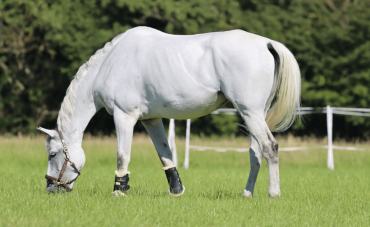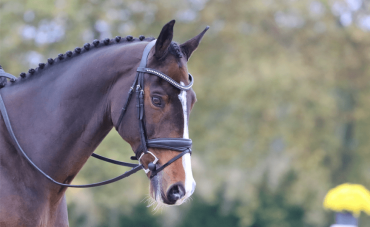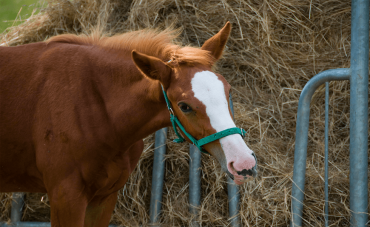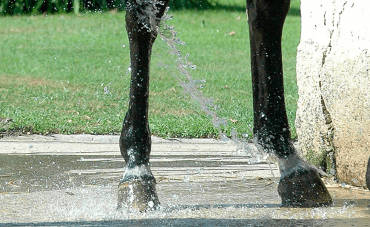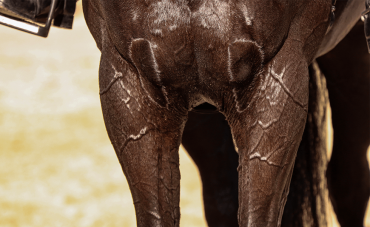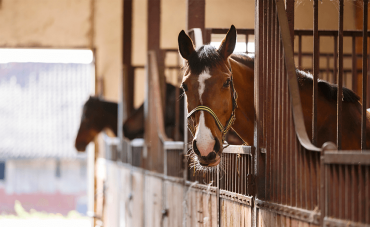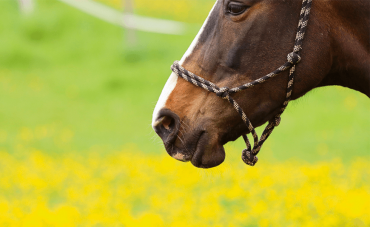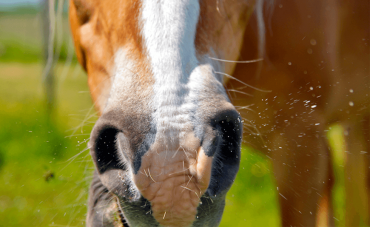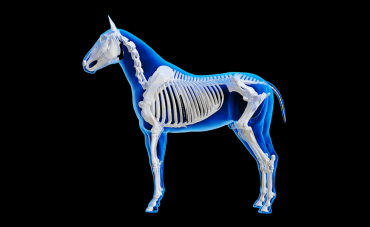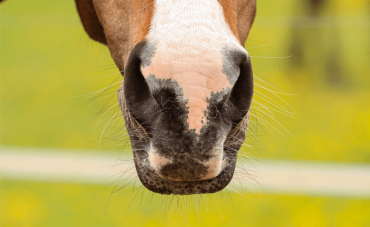In many articles, we've explored the horse's musculoskeletal system and the various conditions that can affect it. Many pathologies impact an essential component of any movement: the joint. Today, let's take a closer look at these crucial joints.
What is a joint?
By definition, a joint is the element that enables movement. It typically involves the connection between two bones, but in the horse, it can also comprise more than two bones. This is the case with joints like the hock or fetlock, which include one or more small bones to ensure stability and support tendons and ligaments.
If we focus on the junction between two bones, the joint consists of various elements, which we will discuss in detail later:
-
- The cartilage
- The synovial membrane, responsible for producing synovial fluid
- The subchondral bone
- The joint capsule, which encircles the joint and defines the joint cavity
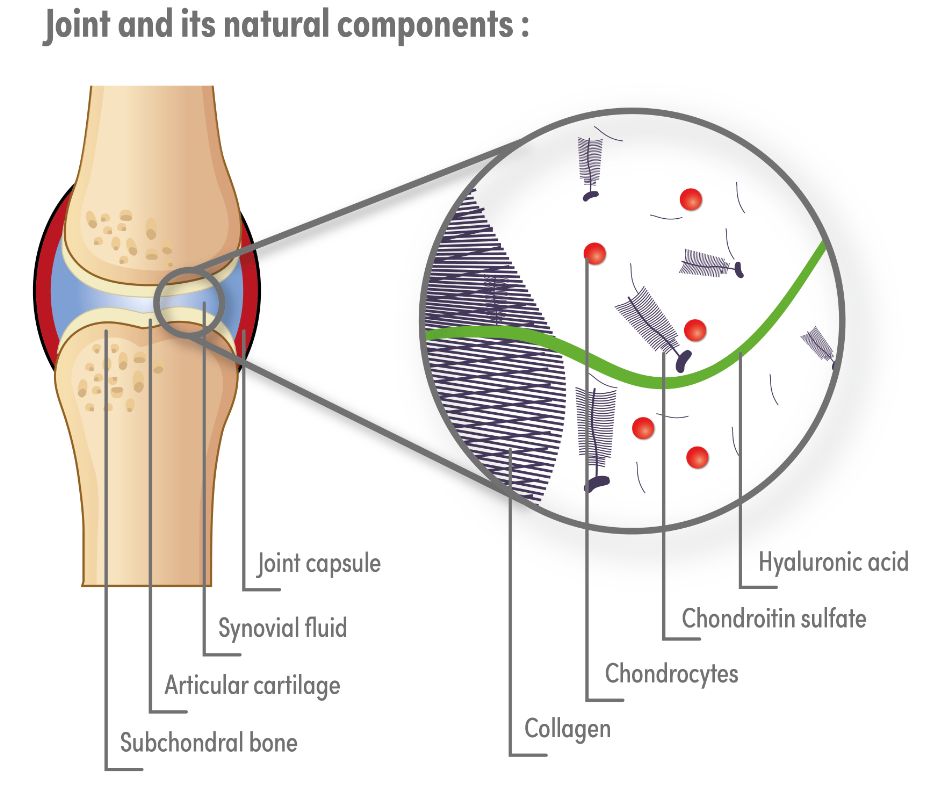
Zoom on the
joint cavity
To comprehend how joints work and what issues can disrupt their proper function, it's crucial to understand the role of each of the joint cavity components.
Cartilage
Cartilage covers the ends of bones and serves to absorb shocks resulting from various stresses applied to the joint. It also prevents friction between the bones. It is the composition of the cartilage that lends it elasticity and shock-absorbing properties.
It comprises various elements, including:
-
- Chondrocytes: cells contributing to the construction of certain cartilage components, though their impact is relatively modest.
- The extracellular matrix: this constitutes the bulk of the cartilage and is primarily responsible for its various functions. It consists of different elements, including:
- A collagen framework which makes the cartilage resistant to the various stresses. Collagen is a glycoprotein (proteins associated with small sugars) and there are different types depending on its location. In the case of cartilage, it is type II collagen.
- An elastic "cement" primarily composed of water, various ions, and hyaluronic acid.
- Aggrecans assemblies, structures enabling cartilage to function as a shock absorber. These consist of a protein (aggrecan) and glycosaminoglycans (GAGs).
As we discussed in our post on joint lifespan, your horse possesses a joint "capital" that gradually diminishes over time. Cartilage deteriorates as your horse ages, and it doesn't regenerate as rapidly as it deteriorates. In case of damage, the repair process is slow, if not impossible. Cartilage degradation can result in increased stress on the bone it covers, potentially leading to issues in your horse's mobility, such as reduced stride length and even lameness
Synovial Fluid
Synovial fluid, or synovium, is a viscous fluid with shock-absorbing properties within the joint. It also facilitates movement, acting as a lubricant, and plays a role in nourishing the cartilage. In a healthy joint, its volume varies according to the joint's size. Synovial fluid is composed of various molecules, including hyaluronic acid, which plays a crucial role in transporting nutrients to the cartilage.
Subchondral Bone
The subchondral bone lies directly beneath the cartilage. Its primary function is to absorb the shocks generated by your horse's movement to prevent them from transmitting to the rest of the bone. Its shock-absorbing effect is as significant as that of the cartilage.
Similar to cartilage and synovial fluid, the subchondral bone comprises several components, such as:
- Inorganic components, specifically hydroxyapatite, representing about 50% of its mass, providing rigidity.
- Organic components, including type I collagen, proteoglycans, glycosaminoglycans, and water, which render it elastic and flexible.
- Nerves and blood vessels, with vessels supplying essential elements to the bone cells and nerves signaling pain to the brain if the subchondral bone deteriorates.
Main joint pathologies and their treatment
As previously discussed, joints are relatively complex structures, and their well-being is vital for your horse to move properly, directly impacting its overall health and performance. In the following section, we'll examine the primary joint disorders.
Osteochondrosis
Osteochondrosis falls under the category of developmental orthopaedic disorders (DOD), encompassing all orthopaedic issues in growing and developing horses. While osteochondrosis can occur in almost any joint, it most commonly affects the fetlocks, hocks, and stifles.
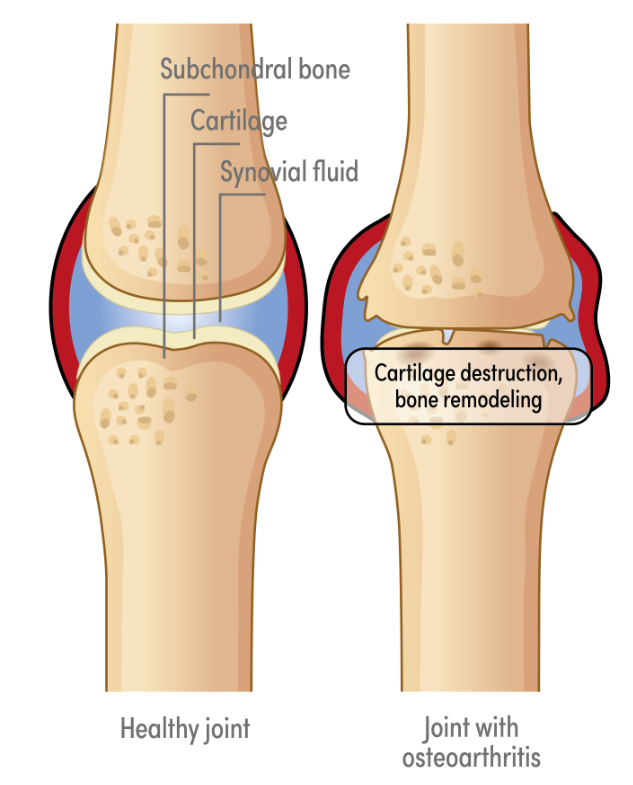
Osteochondrosis stems from a bone defect that develops during a young horse's growth, potentially leading to joint deformities, including:
- Osteochondritis dissecans, where bone fragments can hinder joint function, resulting in inflammation.
- Bone cysts within the subchondral bone.
Various causes contribute to osteochondrosis, including genetics, work intensity at a young age, and dietary factors such as mineral imbalances and a starch-rich diet.
In cases of osteochondrosis, two main treatment approaches are available. Surgical treatment involves the removal of problematic joint fragments, albeit being relatively expensive. Depending on the damage severity and horse type, a veterinarian may recommend conservative treatment, entailing a period of rest, dietary adjustments if necessary, and the use of anti-inflammatories.
For subchondral cysts, veterinarians may advise treatment with bisphosphonates. In situations like osteochondrosis, regular veterinary check-ups are essential.
Osteoarthritis
Osteoarthritis is a degenerative condition that arises when your horse's joints exceed their capacity. It results from wear and tear on the joint, leading to the partial or complete degradation of cartilage and damage to the bone. Osteoarthritis can affect all of the horse's joints, with certain joints at higher risk.
In cases of osteoarthritis, the natural bone remodeling process becomes pathological, with useful bone destroyed and unnecessary bone formed, creating stress that may lead to inflammation and further bone remodeling. While osteoarthritis isn't curable, treatments can help alleviate your horse's discomfort and slow the progression of the condition.
Medication treatments serve two main functions:
- Pain relief, with systemic anti-inflammatory drugs and corticosteroids administered via joint injections.
- Slowing the formation of osteoarthritis using bisphosphonates, which reduce pain in your horse.
We have a comprehensive article dedicated to osteoarthritis.
Preserving Your Horse's Joints
To maintain your horse's joints' health and function for as long as possible, it's crucial to take care of them and implement protective measures. In this section, we offer tips on how to safeguard your horse's joints.
In your horse's daily management, consider several essential factors:
- Monitor your horse's weight regardless of age. Excess weight places greater pressure on joints, potentially accelerating deterioration. Obesity in horses can also lead to other pathologies like laminitis and Cushing's syndrome.
- Regularly maintain your horse's hooves through grooming or a farrier to correct any hoof defects and ensure overall hoof health. You can also apply hoof care products to maintain overall hoof health.
- Provide your horse with regular opportunities for movement. Regular exercise is one of the best ways to promote joint health.
- Be mindful of the ground surface when training. Avoid working your horse on overly hard surfaces, as it can be traumatic for joints, especially when trotting or cantering.
- Always warm up your horse before training, gradually acclimating it to exercise. After working, even in winter, shower your horse's limbs with cold water to stimulate blood circulation and alleviate any inflammation.
To protect your horse's joints or support them if already damaged, consider using feed supplements. Chondroprotective feed supplements can be beneficial for maintaining joint health regardless of your horse's age and ensuring overall locomotor comfort. For example, Ekyflex Arthro Evo provides comprehensive joint protection by nourishing and protecting various joint components, including subchondral bone and cartilage.
In its composition, we find different ingredients that will help to nourish and protect the different parts of the joint:
- PACs (proanthocyanidins) which protect the subchondral bone. This protection allows it to perform its role as a shock absorber correctly, even in horses that work intensively.
- ASU (unsaponifiable matter from soy and avocado) which protects the cartilage.
- Glucosamine: well known as a chondroprotective ingredient, glucosamine is a necessary element for the production of GAGs (one of the components of cartilage). It helps to nourish and protect cartilage
- Peptagen II® which is an ingredient that provides essential amino acids for the production of type II collagen (also a component of cartilage)
- MSM: this ingredient ensures overall comfort and limits stiffness for horses whose joints are already significantly damaged or who train hard.
In addition to joint protection, some horses may experience stiffness due to age or rigorous training. In such cases, supplements containing plant ingredients like Harpagophytum, White Willow, and Boswellia can promote comfort and flexibility. These ingredients are found in our supplements, including Harpagyl, Ekyflex Nodolox, and Ekyflex Mobility.
If you believe your horse might benefit from these supplements, consult your veterinarian, who can recommend the most suitable formula.
In conclusion, taking care of your horse's joints is essential. If you suspect any joint damage or notice a decline in performance, don't delay; contact your vet promptly. Addressing joint issues early leads to better outcomes.

